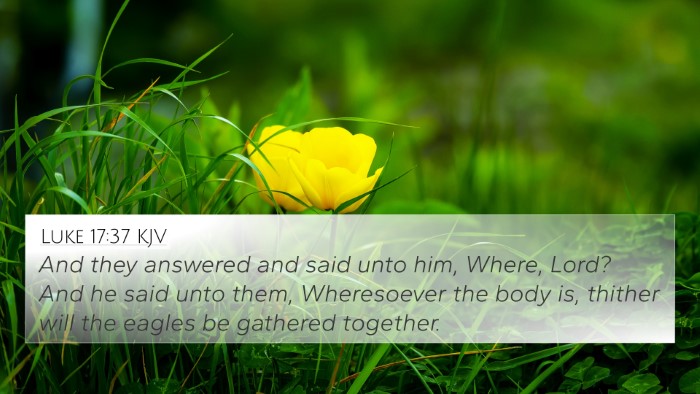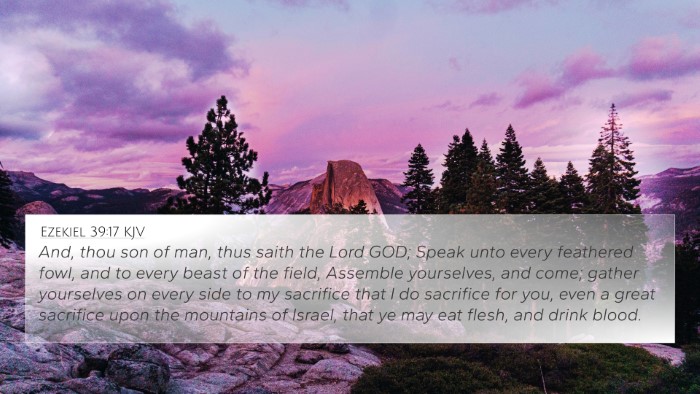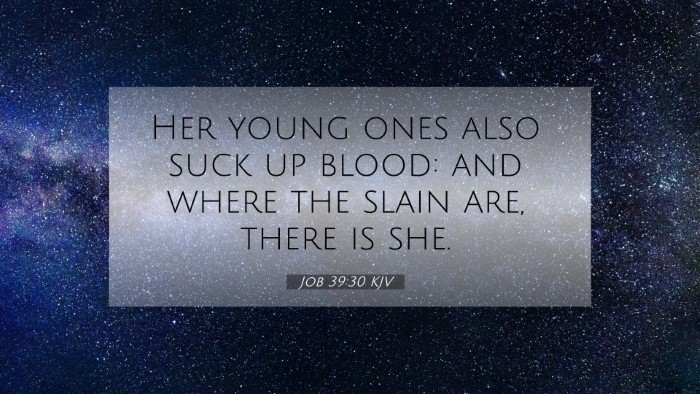Old Testament
Genesis Exodus Leviticus Numbers Deuteronomy Joshua Judges Ruth 1 Samuel 2 Samuel 1 Kings 2 Kings 1 Chronicles 2 Chronicles Ezra Nehemiah Esther Job Psalms Proverbs Ecclesiastes Song of Solomon Isaiah Jeremiah Lamentations Ezekiel Daniel Hosea Joel Amos Obadiah Jonah Micah Nahum Habakkuk Zephaniah Haggai Zechariah MalachiJob 39:30 Similar Verses
Job 39:30 Cross References
Her young ones also suck up blood: and where the slain are, there is she.
Uncover the Rich Themes and Topics of This Bible Verse
Listed below are the Bible themes associated with Job 39:30. We invite you to explore each theme to gain deeper insights into the Scriptures.
Job 39:30 Cross Reference Verses
This section features a detailed cross-reference designed to enrich your understanding of the Scriptures. Below, you will find carefully selected verses that echo the themes and teachings related to Job 39:30 KJV. Click on any image to explore detailed analyses of related Bible verses and uncover deeper theological insights.

Luke 17:37 (KJV) »
And they answered and said unto him, Where, Lord? And he said unto them, Wheresoever the body is, thither will the eagles be gathered together.

Ezekiel 39:17 (KJV) »
And, thou son of man, thus saith the Lord GOD; Speak unto every feathered fowl, and to every beast of the field, Assemble yourselves, and come; gather yourselves on every side to my sacrifice that I do sacrifice for you, even a great sacrifice upon the mountains of Israel, that ye may eat flesh, and drink blood.
Job 39:30 Verse Analysis and Similar Verses
Understanding Job 39:30
Job 39:30 states: "Her young ones also suck up blood: and where the slain are, there is she." This verse contributes to the overall theme of God’s sovereignty and the complexity of His creations, particularly in the natural world.
This verse illustrates the harsh realities of nature, as noted by various commentators. Here is a summary of insights from respected public domain commentaries:
Commentary Insights
-
Matthew Henry:
Henry reflects on the vivid imagery of the verse, emphasizing the fierceness of the creatures within God's creation. He argues that this portrayal serves to highlight the balance of life and death that exists in nature and the providential care of God, even in seemingly brutal circumstances.
-
Albert Barnes:
Barnes comments on the significance of the "young ones" sucking blood, which signifies the harshness of survival in the animal kingdom. He connects this imagery to the greater lessons regarding life and death that are depicted throughout scripture, implying that God uses these elements to teach humanity about His nature.
-
Adam Clarke:
Clarke elaborates on the context of this verse regarding the predatory behavior of the creatures mentioned. He draws parallels to other biblical texts where God discusses His creation and the animal kingdom, emphasizing the importance of recognizing God’s ultimate authority and the natural order He established.
Thematic Connections
This verse can be connected to several themes and other biblical verses, illuminating the intricate relationships between scripture:
- Creation and Providence: Genesis 1:30; Psalm 104:21
- The Nature of Life and Death: Ecclesiastes 3:19-20; Romans 8:20-22
- God’s Sovereignty Over Creation: Psalm 147:9; Isaiah 40:26
- God’s Provision for All Creatures: Matthew 6:26; Luke 12:24
- Lessons from Nature: Job 12:7-10; Proverbs 30:24-28
- Divine Justice and Power: Job 38:39-41; Isaiah 41:10
- The Reality of Suffering: Ecclesiastes 9:2; John 16:33
Cross-Referencing Job 39:30
Through a comparative Bible verse analysis, we can identify key cross-references that further explain Job 39:30. These connections not only deepen our understanding of the verse but also highlight the consistent themes found throughout scripture.
Key Cross References
- Genesis 9:4: God institutes a law regarding blood, emphasizing its life-giving properties.
- Deuteronomy 12:23: Similar teachings on the significance of blood and life in scriptural context.
- Romans 5:12: The relationship between sin, death, and the human condition, resonating with the theme of survival in nature.
- 1 Peter 5:8: The symbolism of a predator, paralleling the idea of vigilance in a world governed by fierce realities.
- Revelation 6:8: Imagery of death and destruction, linking the severity of natural actions to the broader scope of human understanding of mortality.
- Jeremiah 12:4: Reflecting on the wicked prospering, which connects to the seeming injustice in nature and life.
- Matthew 10:29: God’s knowledge of even the smallest creatures, showing His care amidst the brutality of nature.
Conclusion
Job 39:30 encapsulates a compelling perspective on life's struggles, survival, and the interconnections within God's creation. This verse, through cross-referencing biblical texts and engaging with thematic elements, enriches our understanding of divine providence, the cyclical nature of life and death, and the importance of recognizing God’s overarching authority and purpose in all things.



